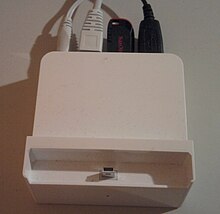



Aplug computer is a small-form-factor computer whose chassis contains the AC power plug, and thus plugs directly into the wall. Alternatively, the computer may resemble an AC adapter or a similarly small device. Plug computers are often configured for use in the home or office as compact computer.
Plug computers consist of a high-performance, low-power system-on-a-chip processor, with several I/O hardware ports (USB ports, Ethernet connectors, etc.). Most versions do not have provisions for connecting a display and are best suited to running media servers, back-up services, or file sharing and remote access functions; thus acting as a bridge between in-home protocols (such as Digital Living Network Alliance (DLNA) and Server Message Block (SMB)) and cloud-based services. There are, however, plug computer offerings that have analog VGA monitor and/or HDMI connectors, which, along with multiple USB ports, permit the use of a display, keyboard, and mouse, thus making them full-fledged, low-power alternatives to desktop and laptop computers. They typically run any of a number of Linux distributions.
Plug computers typically consume little power and are inexpensive.
A number of other devices of this type began to appear at the 2009 Consumer Electronics Show.
{{cite web}}: CS1 maint: unfit URL (link)
|
| |||||||||||||||||||||
|---|---|---|---|---|---|---|---|---|---|---|---|---|---|---|---|---|---|---|---|---|---|
| Micro |
| ||||||||||||||||||||
| Midrange |
| ||||||||||||||||||||
| Large |
| ||||||||||||||||||||
| Others |
| ||||||||||||||||||||
| |||||||||||||||||||||
|
(non-Android) Linux-powered devices
| ||||||||||||||
|---|---|---|---|---|---|---|---|---|---|---|---|---|---|---|
| Computers, components |
| |||||||||||||
| Accessories |
| |||||||||||||
| Historic |
| |||||||||||||
✝ Excluding Android devices. | ||||||||||||||